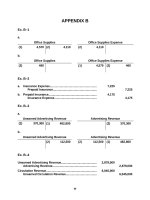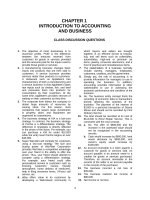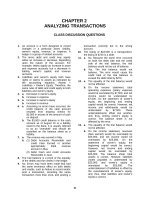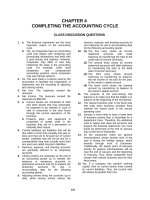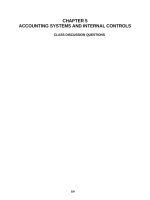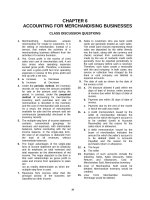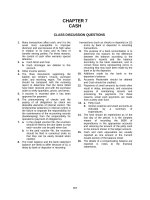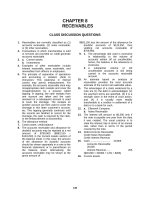Solution manual investments 10th by jones ch10
Bạn đang xem bản rút gọn của tài liệu. Xem và tải ngay bản đầy đủ của tài liệu tại đây (199.92 KB, 23 trang )
Chapter 10:
Common Stock Valuation
CHAPTER OVERVIEW
Similar to the two chapter sequence on bonds, there are two
chapters on common stocks involving first the valuation of the
asset, followed by analysis and management. In addition, the
chapter on efficient markets has been moved to Part IV because
the concept is almost entirely concerned with stocks as far as
students in a beginning Investments course are concerned.
Chapter 10 is one of the most important chapters in the
text. It covers the valuation of common stocks in detail,
including both the discounted cash flow approach and the P/E
ratio approach. Clearly, students should know how to find the
intrinsic value of a stock using the capitalization of income
approach--that is, they should know how to use the Dividend
Discount Model. The eighth edition has been expanded to discuss
other discounted cash flow approaches.
The chapter opens by explaining the present value approach
again (this was also done in Chapter 8 with bonds). This
capitalization of income method seeks to determine the value of a
security (its intrinsic value) by discounting all expected future
cash flows using a required rate of return. This discussion also
includes a brief consideration of the required rate of return
(explained in detail in Chapter 11) and the expected cash flows.
The chapter emphasized the classic Dividend Discount Model,
which is fully developed, including the three growth rate cases:
no growth, constant growth, and multiple growth. However, some
of this material has been moved to an Appendix. Numerous
examples are provided throughout. The purpose of this analysis
is to provide students with the necessary knowledge to work
valuation problems, which are found at the end of the chapter.
Relative valuation models are discussed, with primary
emphasis on the P/E ratio model. The P/E ratio approach is
explained as an alternative way of doing fundamental analysis,
and one that many practicing analysts use. The determinants of
the P/E ratio, using the constant growth model, are examined.
The relationship between P/E ratios and interest rates is
135
considered. Finally, this approach is contrasted to the Dividend
Discount Model.
Other valuation techniques are briefly examined, including
price to book and price/sales ratio. These other techniques
deserve some discussion, but the principal focus remains on the
discounted cash flow techniques and the P/E ratio model.
CHAPTER OBJECTIVES
To explain the nature of fundamental security analysis as it
applies to common stocks.
To explain discounted cash flow models in general, and the
Dividend Discount Model in particular.
To explain relative valuation techniques, with special
emphasis on the P/E ratio model.
To establish a framework for fundamental analysis that is
used in the three chapter sequence on fundamental analysis
(the first three chapters in Part V).
136
MAJOR CHAPTER READINGS [Contents]
Discounted Cash Flow Techniques
[the discounted cash flow (present value) equation]
The Required Rate of Return
[brief description of what it is; more detail in Chapter
11]
The Expected Cash Flows
[brief description of what is involved]
The Dividend Discount Model
[the equation; the 3 growth rate cases]
Dividends, Dividends--What About Capital Gains?
[how dividends plus a terminal price are equivalent to the
estimated stream of all future dividends]
Intrinsic Value and Market Price
[what it is and what it means; rules for stock selection]
The Dividend Discount Model in Practice
[an example of real-world use of this model]
Other Discounted Cash Flow Approaches
[Streetsmart Guide to Valuing a Stock]
The P/E Ratio or Earnings Multiplier Approach to Valuation
[model; definition; importance]
The Valuation Model
[how this information is presented]
Determinants of the P/E Ratio
[factors that affect the P/E ratio; how affected; examples]
Understanding the P/E Ratio
[P/Es reflect investor expectations about growth prospects
and the risk involved]
P/E Ratios and Interest Rates
P/E ratios and interest rates are inversely related]
Relative Valuation Techniques
[based on making comparisons in order to determine value]
P/E Ratios
[is the P/E for a stock lower or higher than justified by
its prospects?; example]
Price/Book Value
[P/E ratios and interest rates are inversely related]
P/S Ratio (PRS)
Economic Value Added
Which Approach to Use?
[both approaches, discounted cash flow techniques and
relative valuation techniques, can be used and both involve
subjective judgments]
Bursting the Bubble on New Economy Stocks—A Lesson in Valuation
[the debacle in dot.com companies; valuation methods do
apply]
Some Final Thoughts on Valuation
[subjective nature of valuation]
Appendix 10-A
The Constant Growth Version of the DDM
Appendix 10-B
The Analysis and Valuation of Preferred Stock
POINTS TO NOTE ABOUT CHAPTER 10
Tables and Figures
Table 10-2 shows the relationship between yields on bonds
and P/E ratios. The general point is that interest rates are
directly related to required rates of return, and that as the
required rate of return increases (decreases), other things
equal, the P/E ratio decreases (increases). Therefore, bond
yields and P/E ratios are usually inversely related.
Figure 10-1 is designed to illustrate the present value
approach to valuation for organizational purposes. The emphasis
is on the determination of intrinsic value, which can then be
compared to current market price.
Figure 10-2 illustrates the
growth company and could be used
purpose of working through these
students have genuine difficulty
(multiple growth) models.
valuation process for a multiple
as a transparency for the
calculations in class. Most
in understanding supergrowth
Exhibit 10-1 shows an actual stock recommendation based on
P/E ratios and earnings. Students can clearly see how this
information is presented by the investment industry to
subscribers of investment advisory services.
Figure 10-3 shows stock market capitalizations and P/E
ratios for groups of stocks for the year 1998. In this
particular case, the largest stocks commanded the highest P/Es.
Figure 10-1A (Appendix) illustrates the constant growth
model using a specific example developed in the text (see Table
10-1A). The point here is to show how the nominal value of
dividends grows over time as compared to the present value of the
dividends.
Table 10-1A illustrates in detail the constant growth
version of the Dividend Discount Model by showing year-by-year
results for a particular set of inputs. Shown are the dollar
dividend, the PV factor, and the PV of the dollar dividend.
Because of the format of the equation, many students fail to
recognize that the constant growth version involves a present
value process and accounts for all dividends from now to
infinity.
Box Insert
Box 10-1 is an interesting popular press discussion of the
DDM and how it can be used to select stocks, particularly with
regard to equation 10-9.
ANSWERS TO END-OF-CHAPTER QUESTIONS
10-1.
The intrinsic value of an asset is its fair economic value
as estimated by investors. This value is a function of
underlying economic variables--specifically, expected
returns and risk.
Traditionally, intrinsic value is determined through a
present value process. The future expected cash flows on
an asset are discounted at a required rate of return.
10-2.
The required rate of return for a stock is the minimum
expected rate of return necessary to induce an investor to
purchase a stock. It accounts for opportunity cost and
the risk involved for a particular stock. If an investor
can expect to earn the same return elsewhere at a lesser
risk, why buy the stock under consideration? Or, put
another way, if your opportunity cost for a given risk
level is 15%, you should not purchase a stock with that
risk level unless you can expect to earn 15% or more from
that stock.
10-3.
Earnings cannot be used directly in the present value
approach because reinvested earnings would be double
counted, first as earnings reinvested currently and later
as dividends paid. If properly defined and separated,
these two variables will produce the same results.
Dividends, however, can be used directly.
10-4.
The Dividend Discount Model is a widely used method to
value common stocks. A present value process is used to
discount expected future dividends at an appropriate
required rate of return. The equation is:
D1
PVcs = ─────
(1+k)
10-5.
+
D2
──────
(1+k)2
D3
D
+ ────── + ... + ──────
(1+k)3
(1+k)
The problems encountered in the dividend discount model
stated as Equation 10-2 in the text, and shown above in
answer number 10-4, include:
(a)
(b)
(c)
The last term indicates we are dealing with infinity.
The dividend stream is uncertain.
The required rate of return has to be determined.
10-6.
The three possibilities for dividend growth are:
(a)
no growth--the dollar dividend will remain fixed.
(b)
constant growth--the dividend will grow at a steady
(constant) rate over time.
(c)
multiple (super growth)--at least two different
growth rates are involved. Many multiple-growth-rate
companies grow rapidly for some years and then slow
down to a more normal growth rate.
The constant growth model is probably the most applicable
to the typical large common stock, and certainly is more
often used, rightly or wrongly (because of its
simplicity). The no-growth case is the least likely to
apply.
10-7.
Although dividends are paid to infinity, they can be
modeled as either (ignoring the no-growth case) a constant
growth rate or a supergrowth situation involving rapid
growth for some years plus a constant growth situation for
the remainder. In either case, the infinity sign is
eliminated.
On a practical basis, after 30 or 40 years dividends
discounted at rates of 10% to 20% (or higher) will have
insignificant value and can be ignored.
10-8.
The dividend discount model can be stated as:
(a)
P0 =
t=1
Dt
──────
(1+k)t
where P0 is the current market price of the stock.
Alternatively, we could say
(b)
n
P0 =
t=1
Dt
──────
(1+k)t
Pn
+ ──────
(1+k)n
In (b), Pn is a function of all dividends to be paid from
n+1 to infinity, or
(c)
Pn =
n+1
Dt
──────
(1+k)t
Substituting the right-hand side of (c) into (b) for Pn
produces (a), putting us back to where we started.
Therefore, the combination of a specified number of
dividends and a terminal price is exactly equivalent to an
infinite number of dividends because the terminal price
takes up where the specified number of dividends stopped
(i.e., it is equal to the discounted value of all future
dividends).
10-9.
The two investors are likely to derive different prices
because:
(a)
They will probably use different estimates of g, the
expected growth rate in dividends.
(b)
They are likely to use different required rates of
return.
10-10. Investors compare intrinsic value (IV) to the current
market price (CMP) of the stock.
If IV > CMP, the stock is undervalued -- buy
If IV < CMP, the stock is overvalued -- sell
If IV = CMP, the stock is correctly valued and in
equilibrium.
10-11. P/E ratios shown daily in The Wall Street Journal reflect
the current market price of the stock divided by the
latest 12 month earnings. Therefore, they show only the
current multiple for a stock. While this can be a useful
reference point, investors seeking to value a stock will
need an estimate of the future multiplier.
10-12. The P/E ratio is affected by:
(a)
(b)
The expected dividend payout ratio (D/E).
The required rate of return.
(c)
The expected growth rate of dividends.
The P/E ratio is quite sensitive to a change in these
factors. A one percentage point change in the required
rate of return, for example, can easily change the price
of a stock 30 or 40%. A one percentage point change in g,
the expected growth rate of dividends, also has a
significant impact, but not as large as a change in the
required rate of return. Both of these factors usually
have more impact than the payout ratio.
10-13. Some analysts argue that the dividend discount model is
unrealistic because it requires a forecast of dividends
into the distant future (technically, infinity). Also,
many investors are seeking capital gains, while this model
seemingly focuses on dividends. In response, it should be
noted that the dividend growth rate can be modeled in a
workable manner, avoiding the infinite horizon problem.
Furthermore, investors can structure a stream of dividends
and a terminal price (which allows for capital gains) and
have an alternative that is equivalent to the basic model.
Perhaps the most important point here is that either
model, the dividend discount model or the multiplier
model, requires estimates of the future. These estimates
cannot be avoided! Whether the inputs for one model as
opposed to the other model are more realistic is probably
an unresolvable argument.
10-14. This analysis is based on the equation (D/E)/(k-g).
(a)
decline
(b)
decline
(c)
increase
(d)
increase*
*the riskless rate of return is a component of the
required rate of return, which has an inverse
relationship with the P/E.
ANSWERS TO END-OF-CHAPTER PROBLEMS
10-1.
Using the constant growth version of the Dividend
Discount Model:
k = D1/P0 + g
= $2.00/$45 + .09
= .1344 or 13.44%
10-2.
Reversing the formula used in answer 10-1 to solve
for price, and recognizing that we must compound the
stated dividend, D0, up one period to obtain D1,
P0 = D1/(k-g)
= D0(1+g)/(k-g)
= $2.25(1+.08) / (.13-.08)
= $2.43/.05
= $48.60
10-3.
Again using the constant growth version of the
Dividend Discount Model, solve for g
Or:
k
k-g
-g
g
g
=
=
=
=
=
D1/P0 + g
D1/P0
D1/P0 - k
k - D1/P0
k - [(D0(1+g))/P0]
g
50g
53g
53g
g
=
=
=
=
=
.15 - [($3.00(1+g))/50]
7.50 - 3 - 3g
7.50 - 3
4.50
08.49 or 8.49%
Therefore:
10-4.
P = D0/k = 1.50/.15 = $10.00
10-5.
(a)
k = D0/P0 = $3.00/$40 = 7.5%
(b)
The price will decline because required rates of
return rise while dividends remain fixed.
Specifically,
P = $3.00/.09 = $33.33
10-6.
Given a one year horizon, this problem can be
formulated as
P0 =
$25
(1+k)25
1+k
k
10-7.
(a)
(b)
=
=
=
=
D1
───────
(1+k)
+
P1
───────
(1+k)
$3.00/(1+k) + $30/(1+k)
3 + 30
33/25 =1.32
32%
(1)
Stock A
kA = RF + ßA (RM-RF)
= .10 + 1.0(.15 -.10)
= .15
(2)
Stock B
kB = .10 + 1.7(.15-.10)
= .185
(3)
Stock C
kC = .10 + .8(.15-.10)
= .14
If RF increases to .12, required rates of return
are:
kA = .12 + 1.0(.03) = .15
kB = .12 + 1.7(.03) = .171
kC = .12 + 0.8(.03) = .144
(c)
If RM increases to 17%, the required rates of
return also rise. The new results are:
kA = .10 + 1.0(.17-.10)
= .17
kB = .10 + 1.7(.17-.10)
= .219
kC = .10 +
0.8(.17-.10) = .156
10-8.
(a)
It is necessary to calculate the growth rate
since it is not given. Referring to the future
(compound) value table at the end of the text,
and reading across the 12 year row, we find a
factor of about 2.0 (actually, 2.0122) at the
intersection of the 6% column (or, using the
rule of 72, 72/12 = 6%). Therefore g = 6% and
k = [$3.00(1.06)]/$60 + .06
= 053 + .06
= .113 or 11.3%
(b)
Using the same table to find a factor of 3.0 on
the 6 year row, we find g to be approximately
20% (the exact factor at 20% is 2.986).
Therefore, using g = 20%,
k = [$3.00(1.20)]/$60 + .20
= .06 + .20
= .26 or 26%
10-9.
(a)
Solving for k as the expected rate of return,
k = [$1.80(1.08)]/$36 + .08
= .054 + .08
= .134 or 13.4%
Since the expected return of 13.4% is less than
the required rate of return of 14%, this stock
is not a good buy.
(b)
P0 = D1/(k-g)
= [$1.80(1.08)]/[.14-.08]
= $32.40
An investor should pay no more than $32.40 if
his or her required rate of return is 14%.
If the required rate of return is 15%, the
maximum an investor should pay is obviously less
than in the previous problem. Specifically,
P0 = [$1.80(1.08)]/[.15-.08]
= $27.77
10-10. (a)
The current P/E ratio is $32/$4 = 8
(b)
E0 = $4
E1 = E0(1+g)
= $4(1+.10)
= $4.40
With an unchanged P/E of 8, the new price
will be
8 x $4.40 = $35.20
(c)
D/E = 50% -- payout ratio
g = 10% -- expected growth rate of dividends
k = 16% -- required rate of return
expected rate of return = D1/P0 + g
= $2.20/$32 + .10
= .169 or 16.9%
Alternatively,
P0 = D1/(k-g)
= $2.20/(.16-.10)
= $36.66
This stock is a good buy because the expected
return exceeds the required return or,
alternatively, the estimated value (price) of
the stock exceeds the current market price.
(d)
If interest rates are expected to decline, the
likely effect is an increase in the P/E ratio
for Joy Juice as well as other stocks.
10-11.
$1.30 (1.11)
──────────── = $30.38
15.75 - .11
10-12.
$1.30 (1.16)
──────────── = no solution
15.75 - .16
This problem cannot be solved using this equation
because the growth rate is greater than the discount
rate (required rate of return).
10-13. Using any computer package that solves stock
valuation problems, the correct price of $32.29
should be produced.
10-14. This problem is a 3-stage growth model, which is
solved exactly as in 10-13 except three growth rates
and the time periods covered are entered rather than
two. The program will produce a price for this stock
of $27.50.
10-15. Lowering the growth rate in the first supernormal
growth period from 30% to 25% will clearly result in
a lower price because of the lesser growth rate in
dividends and the lesser dollar value of the
resulting dividend stream. Making this one
change(obviously, no other changes are necessary)
results in a new price of $23.08.
10-16. D0 = $1.60; k = 16%; g = 8%
$1.60 (1.08)
P0 = ────────────
.16 - .08
=
$1.73
─────
.08
= $21.63
10-17. $2.00 (.40) = $0.80 = D1
The correct growth rate to use is the expected growth
rate of 7%.
P0
$0.80
───────
.08
= $10
10.18. P0 = $0.60 (.847) + $1.10 (.718) + $1.25 (5.556)
(.718)
= $0.51 + $0.79 + $4.99
= $6.29
NOTE: 5.556 is 1/.18 (to account for the
perpetuity). This value must then be discounted back
to today using the 2-year factor since the perpetuity
is valued as of the beginning of year three, which is
the same as the end of year two.
10-19. D1 = $1.80 (1.06) = $1.91
= .90 (since the stock is 10% less risky than the
market)
k = 5% + .9 (7%) =
$1.91
P0 = ──────────────
.113 - .06
11.3%
=
$36.04
10-20. k = D0 / P0
$1.00
k = ─────── = 8.33%
$12
10-21. k = (D1 / P0)+ g
k = $2.00 (1.07) / $40
+
7% =
12.35%
10-22. P0 = ($3.00/.25)(.328) = $3.94
10-23. k = D1/P0 + g
g = k - D1/P0
g = .10 - $2.00/$50
= .06
10-24. P0 = $10 (4.192) + $15 (5.00) (.162)
= $41.92 + $12.15 = $54.07
NOTE:
factor
factor
for 10
4.192 is the present value of an annuity
for 10 periods at 20%. 5.00 is the perpetuity
for 20%, and .162 is the present value factor
periods, 20%.
10-25. This is a 2-stage growth model, or supergrowth.
the present value of all dividends from now to
infinity.
n
P0 =
t=1
D0(1+g1)t
Dn(1+gc)
─────────── + ──────────
(1+k)t
k-gc
Find
1
────────
(1+k)n
where g1 is the supergrowth rate in dividends, gc is
the constant growth rate, and n is the number of
years of supernormal growth. Solving for the present
value of the dividends for the first five years of
supergrowth:
D0
D1
D2
D3
D4
D5
= $1.00
= 1.00(1.25)
= 1.00(1.25)2
= 1.00(1.25)3
= 1.00(1.25)4
= 1.00(1.25)5
=
=
=
=
=
$1.25
1.56
1.95
2.44
3.05
PVIF.18
.847
.718
.609
.516
.437
PV of dividends for first 5 years =
PV
in $
$1.06
1.12
1.19
1.26
1.33
$5.96
D5(1+gc)
$3.05(1.07)
$3.26
P5 = ──────────── = ─────────────── = ───────── = $29.67
k-gc
.18 - .07
.11
We must discount P5 back to time period zero and add
this value to the present value of the first five
years of dividends.
NOTE: P5 is the price at the end of year five;
therefore, we use the discount factor for 5 years,
not 6 years.
P5 discounted to time period zero:
P5 (PVIF.18,5) = $29.67(.437) = $12.97
P0 = $5.96 + $12.97 = $18.93
10-26. This is a three stage growth model. It is unusual in
that in the second stage of growth, the growth rate
is equal to the discount rate. The process remains
the same.
D0 = $2.00
PVIF.20 PV in $
D1 = 2.00(1.30) = $2.60
.833
$ 2.17
2
30% = g D2 = 2.00(1.30) = 3.38
.694
2.35
D3 = 2.00(1.30)3 = 4.39
.579
2.54
----------------------------------------------------------D4 = D3(1.20) = $4.39(1.20) = $5.27 .482
2.54
D5 = D4(1.20) =
5.27(1.20) = 6.32 .402
2.54
20% = g D6 = D5(1.20) =
6.32(1.20) = 7.58 .335
2.54
D7 = D6(1.20) =
7.58(1.20) = 9.10 .279
2.54
D8 = D7(1.20) =
9.10(1.20) = 10.92 .233
2.54
──────
$19.76
D8(1.06)
$10.92(1.06)
$11.58
P8 = ───────── = ──────────── = ────── = $82.71
.20 - .06
.14
.14
Discounting P8 back eight periods:
$82.71(.233) = $19.27
P0 = $19.76 + $19.27 = $39.03
10-27. This is a case of three years of zero dividends,
followed by a no-growth period of infinite length.
Note that one year prior to the start of the nogrowth period is year 3. Therefore,
P3 = D/k = $1/.14 = $7.14
P0 = P3 (PVIF.10,3) = $7.14 (0.675) = $4.82
CFA
10-28. a.
D1
VALUE0 = -----K - g
D1 = next year’s dividend
K = required rate of return
g = constant growth rate
D1 = (EPS0)(1 + g)(P/0) = (4.50)(1.045)(.55) =
$2.59
K = given at 11% or .11
g = (ROE)(1 - P/0) = (.10)(1 - .55) = .045
$ 2.59
VALUE0 = ────────
.11-.045
b.
=
$2.59
──────
.065
=
$39.85
Multistage Dividend Discount Model (where g1 = .
15 and g2 is .045):
D1
VALUE1 = ───── +
(1+K)
D2
────── +
(1+K)2
D3/(K-g2)
─────────
(1+K)2
D1 = (EPS0)(1 + g1)(P/0) = (4.50)(1.15)(.55) = $2.85
D2 = (D1)(1 + g1) = ($2.85)(1.15) = $3.27
K = given at 11% or .11
g2 = .045
D3 = (D2)(1 + g2) = ($3.27)(1.045) = $3.42
VALUE0 = $2.85
$3.27
3.42/(.11-.045)
────── + ─────── + ───────────────
(1.11)
(1.11)2
(1.11)2
$2.85
$3.27
$52.62
────── + ─────── + ───────
(1.11)
(1.11)2
(1.11)2
=
$2.56 + $2.65 + $42.71
=
$47.92
CFA
10-29.
(a)
The dividend discount model is:
P =
d
─────
k - g
Where P - value of the stock today
d - annual dividend one year forward
k - discount rate
g - constant dividend growth rate
Solving for k:
d
d
(k - g) = ───; then k = ─── + g
p
p
So k becomes the estimate for the long-term
return of the stock.
$.60
k = ────── + 8% = 3% + 8% = 11%
$20.00
(b)
Many professional investors shy away from the
dividend discount framework analysis due to its
many inherent complexities.
(1)
The model cannot be used where companies
pay very small or no dividends and
speculation on the level of future
dividends could be futile. (Dividend policy
may be arbitrary.)
(2)
The model presumes one can accurately
forecast long term growth of earnings
(dividends) of a company. Such forecasts
become quite tenuous beyond two years out.
(A short-term valuation may be more
pertinent.)
(3)
For the variable growth models, small
differences in g for the first several
years produce large differences in the
valuations.
(4)
The correct k or the discount rate is
difficult to estimate for a specific
company as an infinite number of factors
affect it which are themselves difficult to
forecast, e.g., inflation, riskless rate of
return, risk premium on stocks and other
uncertainties.
(c)
(5)
The model is not definable when g > k as
with growth companies, so it is not
applicable to a large number of companies.
(6)
Where a company has low or negative
earnings per share or has a poor balance
sheet, the ability to continue the dividend
is questionable.
(7)
The components of income can differ
substantially, reducing comparability.
Three alternative methods of valuation would
include:
(1)
(2)
(3)
(4)
(5)
CFA
10-30. A.
Price/Earnings ratios
Price/Asset value ratios (including market
and book asset values)
Price/Sales ratios
Liquidation or breakup value
Price/cash flow ratios
The formula for the constant growth discounted
dividend model is shown below:
Price
D0 (1 + g)
────────────
k - g
=
Where D0 = current dividends per share
For Eastover:
Price
=
1.20 * 1.08
───────────── = 43
0.11 - 0.08
This compares with its current stock price of
28. On this basis, it appears that Eastover is
undervalued.
B.
The formula for the two-stage discounted
dividend model is as follows:
D1
D2
D3
P3
Price: ───── + ─────── + ─────── + ───────
1+k
(1+k)2
(1+k)3
(1+k)3
D4
where P3 = ────────
k - g2
For Eastover:
D0
D1
D2
D3
D4
=
=
=
=
=
1.20
1.20
1.20
1.20
D3
g1 = .12
g2 = .08
*
*
*
*
1.12
(1.12)2
(1.12)3
(1.08)
=
=
=
=
1.34
1.50
1.69
1.82
P3 = 1.82 / (.11 - .08) = 60.67
1.34
1.50
1.69
60.67
Price = ──── + ─────── + ─────── + ───────
1.11
(1.11)2
(1.11)3
(1.11)3
= 48.03
This approach indicates that Eastover is even
more undervalued than was the case with the
constant growth approach.
An alternative solution to two-stage model is:
D1
D2
P2
Price = ───── + ────── + ──────
(1+k)
(1+k)2
(1+k)2
D3
P2 = ────
k-g2
=
1.69
─────── = 56.33
.11-.08
1.34
1.50
56.33
Price = ──── + ─────── + ────────
1.11
(1.11)2
(1.11)2
= 1.21 + 1.22 + 45.72
= 48.15
This answer differs from previous answer
because of round off error.
C.
Constant growth model:
Advantages:
1)
2)
3)
Disadvantages:
1)
2)
3)
4)
5)
6)
7)
8)
logical, theoretical
basis
simple to compute
inputs can be estimated
very sensitive to inputs
of growth
g and k difficult to
estimate accurately
result is meaningless if
g > k
constant growth is an
unrealistic assumption
assumes growth will never
slow down
dividend payout must
remain constant
not usable for firms not
paying dividends
assumes stock price will
increase at g
Improvements with the two-stage model:
1.
The two-stage model is more realistic.
It accounts for low, high, or zero
growth in the first stage, followed by
constant long-term growth in the second
stage.
2.
The model can solve for stock value when
the growth rate in the first stage
exceeds the required rate of return.

